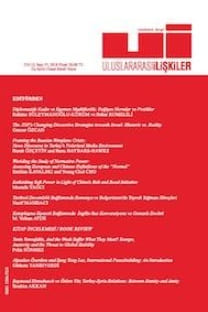Uluslararası Hukukta İkincil Yaptırımlar Açısından Amerika’nın Hasımlarıyla Mücadele Yasası
Amerika’nın Hasımlarıyla Mücadele Yasası (CAATSA), ABD’nin kendine hasım gördüğü Kuzey Kore, İran ve Rusya’ya uygulayacağı yaptırımları belirleyen bir ulusal hukuk belgesidir. Yasanın kimi maddeleri, bu üç devletle önemli işlem yapan üçüncü taraflar için de yaptırımlar getirmektedir. Yürürlüğe girdiği 2017 tarihinden itibaren uluslararası toplumun tepkisini çeken yasa üzerine yapılan akademik araştırmalarda konunun politik yönüne odaklanılırken, uluslararası hukuk boyutu göz ardı edilmiştir. Araştırma yasanın öngördüğü ikincil yaptırımları uluslararası hukuk açısından değerlendiren ilk araştırmadır. Araştırmada, yasanın ilgili hükümleri ikincil yaptırımlar hakkındaki literatür ışığında incelenmiş ve devletlerin egemenlik yetkisi, uluslararası örgüt kararları, uluslararası yargı ve hakemlik ile uluslararası toplumun tepkisi olmak üzere dört başlıkta değerlendirilmiştir. Değerlendirme sonucunda, henüz kodifiye edilmiş bir kural olmamasına rağmen, ikincil yaptırımların uluslararası hukuka aykırı olduğu yönünde çok güçlü deliller olduğu görülmüş, bu doğrultuda CAATSA’nın ikincil yaptırım hükmündeki maddelerinin uluslararası hukuka aykırı olduğu sonucuna ulaşılmıştır.
Anahtar Kelimeler:
Amerika’nın Hasımlarıyla Mücadele Yasası (CAATSA), İkincil Yaptırım, Sınırötesi Yaptırım, S-400, ABD
The Countering America’s Adversaries Through Sanctions Act in Terms of Secondary Sanctions in International Law
The Countering America’s Adversaries Through Sanctions Act (CAATSA) is national legal document that permits the United States to impose sanctions on countries it regards as adversaries, namely North Korea, Iran, and Russia. Certain sections of the act also permit sanctions against third parties who engage in significant transactions with these three states. Since entering into force in 2017, the international community has criticized CAATSA, while academic research about the sanctions legislation has focused on the politics of this issue, failing to study how it accords with international law. This is the first study that analyzes the secondary sanctions stipulated in the act from the perspective of international law. It examines the relevant sections of the act in light of the literature concerning secondary sanctions and discusses them under four titles: jurisdiction of states, decisions by international organizations, international jurisdiction and arbitration, and reactions of the international community. The discussion concludes by pointing out very strong evidence that CAATSA’s secondary sanctions contravene international law, despite it not yet being codified, and thereby argues that the secondary sanctions-related provisions are internationally unlawful.
Keywords:
Countering America’s Adversaries Through Sanctions Act (CAATSA), Secondary Sanction, Extraterritorial Sanction, S-400, United States of America,
___
- Evgeny Pashentsev, “‘Countering America’s Adversaries Through Sanctions Act’: The Psychological Aspect and Its Meaning for EU-Russia Relations”, Evgeny Pashentsev (der.), Strategic Communication in EU-Russia Relations, Cham, Palgrave Macmillan, 2020, s. 213-256.
- Andrei Guter-Sandu ve Elizaveta Kuznetsova, “Theorising Resilience: Russia’s Reaction to US and EU Sanctions”, East European Politics, Cilt 36, No 3, 2020, s. 1-19.
- P.I. Tolmachev, “The Peculiarities of Russia’s Financial Strategy in the Context of the US Law Countering America’s Adversaries Through Sanctions Act, H.R. 3364”, Вопросы новой экономики, Cilt 1, 2018, s. 16-26.
- Elizabeth Zolotukhina, “CAATSA: More of the Same, A Novelty, or a Hidden Danger?”, Centre for Geopolitics & Security in Realism Studies, 2018, s. 2-9.
- ISSN: 1304-7310
- Başlangıç: 2004
- Yayıncı: Uluslararası İlişkiler Konseyi Derneği İktisadi İşletmesi
Sayıdaki Diğer Makaleler
Uluslararası Hukukta İkincil Yaptırımlar Açısından Amerika’nın Hasımlarıyla Mücadele Yasası
Alexander Betts and Paul Collier, Refuge: Transforming a Broken Refugee System
Tolgahan Akdan, Soğuk Savaş ve Türkiye’nin Batı’ya Yönelişi
Suudi Arabistan-İran Bölgesel Rekabetinde Suudi Dış Yardımlarının Siyasi Etkinliği (2010-2020)
